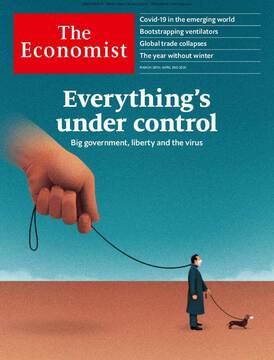
本期经济学人杂志【Leaders】板块下这篇题为《America’s emergency stimulus is imperfect but necessary》的文章关注的是为应对冠状病毒大流行,美国国会参议院通过 2 万亿美元经济刺激法案(特朗普已签署批准)。文章支持这一紧急刺激法案,但也认为它会像以往的救援计划那样带来不公平。
面对无人光顾的商场、被废弃的办公室和数以百万计的民众生活在封锁状态,经济政策制定者们的身上担负着两个重要的责任:
- 一、保护因封锁举措无法工作的人的收入;
- 二、必须确保当日常生活恢复时,经济能够快速反弹。
美国国会参议院 25 日投票通过了 2 万亿美元财政刺激法案,以应对新冠肺炎疫情,防止美国经济陷入严重衰退。这也是美国现代历史上规模最大的经济刺激措施。该计划包括:提高失业金、向小企业提供贷款和向大多数美国成年人每人发放 1,200 美元等。
3 月 23 日,美联储宣布实施极度宽松的货币政策,将无限量购买美国国债和抵押贷款支持证券。紧急刺激法案和美联储政策双管齐下共同应对新冠疫情,一旦封锁举措取消,财政刺激将助力经济增长。
法案通过后市场振奋,不仅因为它将影响经济增长,还因为它直接利好投资者。大企业将能够获得大量贷款(本质上用的是纳税人的钱),美联储也将直接购买短期企业债券。紧急刺激计划实际上是将危机成本从投资者转嫁给了纳税人。
但文章认为该紧急刺激计划是必要的,因为如果任由大量大企业破产倒闭可能会使危机加剧。且投资者也不完全不该得到一些好处。此次紧急刺激真正的不公平之处在于:实际实施过程中,大企业会比小企业和失业者们更顺利和更容易借到钱。
在美国小企业雇佣了 52% 的私营部门工人,一项估计显示他们中有一半人身上只有不到一个月的现金缓冲。法案计划直接向这些工人发放贷款。法案还规定只要企业不裁员,它们在履行某些义务的情况下可以免除政府贷款,比如发放工资、缴纳水电煤气费、租金和抵押贷款等。文章认为,相比欧洲国家直接支付大部分暂停工作工人的工资的做法,美国的计划要复杂许多,很难想象这种计划具体实施起来会快捷而有效率。
对每人发放 1,200 美元的现金救济的计划,文章认为虽然这么做简单粗暴,但 1,200 美元对失业者来说帮助不大,他们将依靠法案中规定的每周额外增加的 600 美元失业救济金度日。另外,8.5% 的美国人缺少医疗保险,一旦有些失业者患病的风险增加,他们也将面临这样的问题。

America’s emergency stimulus is imperfect but necessary
The medicine tastes bad
America’s emergency stimulus is imperfect but necessary
Like past rescue packages, this one could leave a lingering sense of unfairness
Leaders
Mar 26th 2020 edition
Mar 26th 2020
NO TEXTBOOK WAS ever written to tell economists what to do in the face of the extraordinary economic hiatus caused by covid-19. Yet as they consider the deserted malls, abandoned offices and billions of lives on hold, the overarching responsibilities of economic policymakers are clear. First, they must protect the incomes of those who cannot work during lockdowns through no fault of their own. Second, they must make sure that growth bounces back fast when daily life resumes.
The enormous emergency spending bill due to be passed by America’s Congress—which will cost the taxpayer about $2trn (10% of GDP) up front and support much more in new lending—goes some way to discharging both duties. It beefs up unemployment benefits, provides emergency loans and grants to small businesses, and gives $1,200 unconditionally to most Americans. When combined with the ultra-loose monetary policy of the Federal Reserve, which this week announced that it would buy government and mortgage debt in unlimited quantities, the fiscal boost will underpin growth once lockdowns are lifted. America now stands in contrast to some other parts of the world, such as the euro area, where markets expect a prolonged disinflationary slump (see article).
But the bill also brings dangers. Markets cheered it not just because of its likely effect on growth, but also because it directly benefits investors. Large firms will have access to cheap taxpayer-financed loans on an unprecedented scale. The Fed had already announced, on March 23rd, that it would buy companies’ short-term debt. Congress is now giving the central bank a capital infusion to support vast direct lending to corporate America. Emergency interventions like these shift the costs of the crisis away from investors and towards taxpayers (see article).
That is partly necessary, because letting a large number of big firms go bankrupt could prove so disruptive that it would worsen the crisis. And investors are not completely undeserving beneficiaries. No firm could have been expected to stockpile cash to pay workers to do nothing in the event of a government-enforced lockdown. The real potential unfairness in the stimulus is that aid to large firms is the part of the rescue package that is most likely to work without a hitch. Sophisticated corporations will have no trouble borrowing from the Fed or from backstopped capital markets, even as they lay off some workers (prohibited only “to the extent practicable”). But aid to small firms, and directly to the jobless, may turn out to be less than comprehensive.
Small businesses employ 52% of private-sector workers. Half have a cash buffer of less than one month, by one estimate. The bill starts a new programme to lend to them directly. The part of any government loan used to pay wages, utility costs, rent or mortgages will be forgiven—except if firms lay off workers, in which case the subsidy will be reduced in proportion to the number of jobs lost. This scheme is more complex than those in some European countries, under which governments are paying most of the wages of suspended workers. It is hard to imagine that its administration will be quick and efficient. And some analysts think the pot of money on offer is too small (see article). Those most adept at navigating the bureaucracy may get most of the benefit.
Cash handouts to the public are simple enough. But $1,200 is not much help for a laid-off worker. The jobless will rely on the bill’s temporary expansion of unemployment insurance benefits by $600 per week. Yet America cannot construct an adequate social safety-net overnight. For example, 8.5% of Americans lack health insurance. Some workers who are laid off will join their ranks just as they face a heightened risk of falling ill.
Make no mistake: we would vote for the bill, most of which is urgent and necessary. But it is far from perfect. And just like past emergency stimulus, it could work better for big firms than for anyone else, leaving a lingering sense of injustice. ■
This article appeared in the Leaders section of the print edition under the headline"Mixed medicine"
